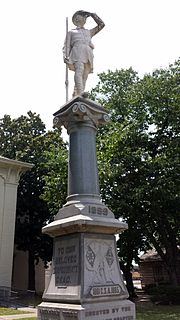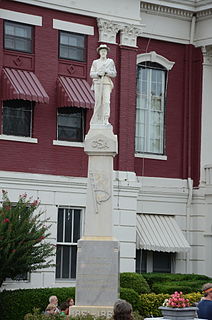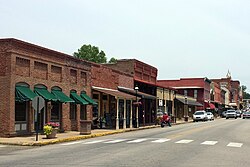
Van Buren is the second largest city in the Fort Smith, Arkansas-Oklahoma Metropolitan Statistical Area and the county seat of Crawford County, Arkansas, United States. The city is located directly northeast of Fort Smith at the Interstate 40 - Interstate 540 junction. The city was incorporated in 1845 and as of the 2010 census had a population of 22,791, ranking it as the state's 22nd largest city, behind Searcy.

Monroe Park is a 7.5 acres (3.0 ha) landscaped park 1 mile (1.6 km) northwest of the Virginia State Capitol Building in Richmond, Virginia. It is named after James Monroe, the fifth President of the United States (1817–1825). The park unofficially demarcates the eastern point of the Fan District and is Richmond's oldest park.

The Denton County Courthouse-on-the-Square is the former courthouse of Denton County located in the county seat Denton, Texas. The Denton County Courthouse-on-the-Square was constructed in 1896. In addition to county offices, the "Courthouse-on-the-Square Museum" also calls it home. The courthouse is listed on the National Register of Historic Places.

The Confederate Monument in Murray is a statue located in the northeast corner of the Calloway County Courthouse in Murray, Kentucky. It honors the 800 citizens of the county who served in the Confederate Army during the American Civil War, and is one of several Confederate monuments in Kentucky featuring Robert E. Lee. There is another one in Bardstown KY. Despite recent controversy, the Calloway County Fiscal Court voted to keep the statue on its grounds in July 2020.

U.S. Route 64 is a U.S. highway running from Teec Nos Pos, Arizona east to Nags Head, North Carolina. In the U.S. state of Arkansas, the route runs 246.35 miles (396.46 km) from the Oklahoma border in Fort Smith east to the Tennessee border in Memphis. The route passes through several cities and towns, including Fort Smith, Clarksville, Russellville, Conway, Searcy, and West Memphis. US 64 runs parallel to Interstate 40 until Conway, when I-40 takes a more southerly route.

The Keokuk County Courthouse located in Sigourney, Iowa, United States, was built in 1911. It was individually listed on the National Register of Historic Places in 1981 as a part of the County Courthouses in Iowa Thematic Resource. In 1999 it was included as a contributing property in the Public Square Historic District. The courthouse is the fourth building the county has used for court functions and county administration.

The Albert Pike Memorial is a public artwork in Washington, D.C. honoring Albert Pike (1809–1891), a senior officer of the Confederate States Army as well as a poet, lawyer, and influential figure in the Scottish Rite of freemasonry. The memorial, which now only includes the base and Goddess of Masonry sculpture, is sited near the corner of 3rd and D Streets NW in the Judiciary Square neighborhood. The memorial's two bronze figures were sculpted by Gaetano Trentanove, an Italian-American artist responsible for another Washington, D.C. sculptural landmark, the Daniel Webster Memorial. The dedication ceremony in 1901 was attended by thousands of Masons who marched in a celebratory parade.

The Van Buren Confederate Monument is located in front of the Crawford County Courthouse in Van Buren, Arkansas. Built in 1899 by the Mary Lee Chapter of the United Daughters of the Confederacy, the structure was initially erected in Fairview Cemetery. Honoring Confederate dead from the Battle of Pea Ridge, Battle of Prairie Grove, and the Battle of Wilson's Creek, the Sons of the Confederacy requested the memorial be relocated to the courthouse lawn in 1906, and it has remained there ever since. The monument was listed on the National Register of Historic Places in 1996 as part of the Civil War Commemorative Sculpture Multiple Property Submission.

The Dardanelle Confederate Monument is located near the Yell County Courthouse on Union Street in Dardanelle, Arkansas, United States. Erected by the United Daughters of the Confederacy (UDC) in 1921, the monument was added to the National Register of Historic Places in 1996 as part of the Civil War Commemorative Sculpture Multiple Property Submission.

The Star City Confederate Memorial is located at the southwest corner of the town square of Star City, Arkansas. The marble monument depicts a Confederate Army soldier standing in mid stride with his left foot forward. His hands hold the barrel of a rifle, whose butt rests on the monument base. The statue is about 6 feet (1.8 m) high and 2 feet (0.61 m) square; it rests on a marble foundation that is 20 feet (6.1 m) long, 12 feet (3.7 m) wide, and 8 feet (2.4 m) high. The monument was erected in 1926 by a local chapter of the United Daughters of the Confederacy at a cost of about $2,500.

The El Dorado Confederate Monument is located on the grounds of the Union County Courthouse in El Dorado, Arkansas, near the corner of North Main and South Washington Streets. It consists of a statue of a Confederate Army soldier in mid-stride, mounted on top of a temple-like structure supported by four cannon-shaped Ionic columns. The columns support a lintel structure bearing inscriptions on three sides, above which is a tiered roof with cannonballs at the corners. The temple structure is 15 feet (4.6 m) high, and 10 feet (3.0 m) square; the statue measures 76 inches (1.9 m) by 28 inches (0.71 m) by 28 inches (0.71 m). Both the statue and the temple are constructed of gray/blue striated marble. Inside the temple structure is a water fountain that no longer works.

The Camden Confederate Monument, also known as the Confederate Women's Memorial, is located on the grounds of the Ouachita County Courthouse in Camden, Arkansas. The sculpture, carved out of Italian marble, depicts a woman dressed in the period of the American Civil War, standing with her feet together, clutching a flagpole. The sculpture is mounted on a block of North Carolina granite, next to a tall obelisk. The statue is 5 feet (1.5 m) tall. The obelisk is inscribed on three sides, recognizing the valor of women in the Confederate cause, and the organizations that funded the memorial's construction. The memorial was erected in 1914 by the local chapters of the United Confederate Veterans and the United Daughters of the Confederacy.

The Robert E. Lee Monument is a U. D. C. memorial built to honor Lee County's Confederate veterans. The monument was carved by the McNeel Marble Co. It is located in Marianna, Arkansas, across from the Lee County Courthouse. Dedicated in 1910, it is one of several monuments built to honor Confederate soldiers. The structure is a local tourist attraction and, since 1996, has been listed in the National Register of Historic Places.

Fairview Cemetery, also known as the Van Buren Cemetery, is a historic cemetery on the east side of Arkansas Highway 59 in Van Buren, Arkansas. The 10-acre (4.0 ha) cemetery's oldest graves date to 1816, the period of the region's settlement, and include some of Van Buren's first settlers. First established as an informal private burial ground, it was given to the city by John Drennen in 1846.

The Ft. Smith Confederate Monument stands on the grounds of the Sebastian County Courthouse at the junction of 6th and Rogers Streets in Fort Smith, Arkansas. The statue depicts a Confederate Army soldier, standing facing north, holding the upper stock of his rifle, which is grounded. The sculpture is 6 feet (1.8 m) in height, and is mounted on a square columnar pedestal over 30 feet (9.1 m) tall. The monument was placed in 1903 with funding raised by the local chapter of the Daughters of the Confederacy. An earlier Confederate memorial, placed at Fort Smith National Cemetery, was destroyed by a tornado, and the federal government objected to the placement of this memorial there without alterations to also commemorate the Union dead. The city granted permission for its placement at its current location.

The Pine Bluff Confederate Monument has long been located in front of the Jefferson County courthouse, at Barraque and Main Streets in Pine Bluff, Arkansas. It depicts a standing Confederate Army soldier, holding a rifle whose butt rests on the ground. The statue, built out of Georgia marble by the McNeel Marble Company, stands on a stone base 15 feet (4.6 m) in height and 10 by 10 feet at the base. It was placed in 1910 by the local chapter of the United Daughters of the Confederacy.

The Lonoke Confederate Monument is located in central downtown Lonoke, Arkansas, on the grounds of the Lonoke County Courthouse. It is a marble depiction of a Confederate Army soldier, 6 feet (1.8 m) in height, mounted on a square columnar base almost 15 feet (4.6 m) tall. The soldier holds a rifle, its butt resting on the ground, and carries a bedroll. He has a belt on which there are a canteen and bayonet. The statue was commissioned by the local chapter of the United Daughters of the Confederacy and was unveiled in 1910.

The Searcy Confederate Monument stands on the grounds of the White County Courthouse, near the corner of West Arch Avenue and Spring Streets, in Searcy, Arkansas. It is a marble statue, depicting a Confederate Army soldier, standing at rest with his rifle resting on the ground. The statue is about 6 feet (1.8 m) in height, and is mounted on a granite base that is 16 feet (4.9 m) tall and 6 feet (1.8 m) square. The base is inscribed in commemoration of White County's soldiers who served in the Confederate Army. The statue was placed in 1917; it was funded through a public fund-raising campaign.



























